
Original Link: https://www.anandtech.com/show/2369
Ultra Products is a well-known name that hardware enthusiasts have looked to for years. While their product line is very broad, including everything from mouse pads to MP3 players, their cases and power supplies are arguably their most popular offerings. There is also a strong emphasis on cooling in the design of these products.
Cooling and noise have both become more of an issue in recent years, and the continuous tug-of-war between components which focus on one of these attributes at the expense of the other have sharply divided enthusiasts. Certainly, dissipating large amounts of heat is simple if you don't mind surrounding (and filling) your case with noisy, high-RPM fans. Conversely, noise is easy to remove if you take all the fans out of a computer - though the risk of having the resulting heat damage critical components certainly increases.
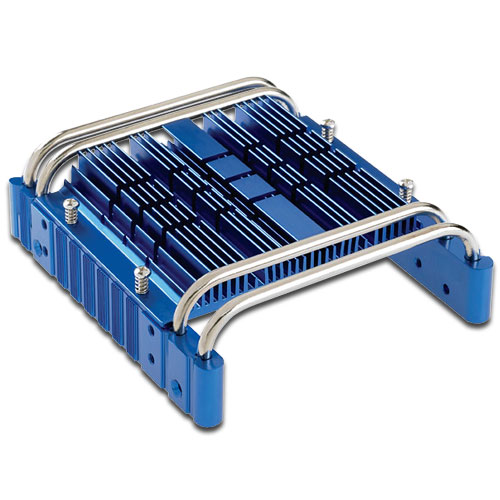
Throughout the years, companies have dealt with the most obvious sources of heat - CPUs and video cards - and most enthusiasts are already familiar with the various players in those markets. It has only been in the last few years, however, that hard drive cooling has received serious attention by manufacturers. Various approaches to dealing with the issue of hard drive heat are available, each with strengths and weaknesses. For their part, Ultra Products has maintained an active cooling design in their HD coolers, choosing to follow an inexpensive approach of simply increasing airflow around the hard drive by using fans. This approach, while effective, eliminates their products from consideration by people for whom noise reduction is paramount - home theatre PC users, for example - and with increasing numbers of desktops finding their way into living rooms, this segment of the market is getting too large to ignore.
With this in mind, Ultra Products has launched their first passive HD cooler, the ULT40010. Will it prove effective at cooling today's hard drives without any sort of fan? We'll put the ULT40010 to the test in our labs, and see if there is indeed a reason to pursue the fanless life.
Specifications
| Ultra ULT40010 Hard Drive Cooler | |
| Heatpipe Material | Sintered Powder Heatpipe |
| Heatsink Material | Aluminum |
| Grounding | Wire Grounding |
| Dimensions | 143 x 122 x 42mm |
| Weight | 402g |
| . | |
The ULT40010 is a passive 3.5" hard drive cooler. The unit is an attractive blue aluminum, bristling with cooling fins along the top of the cooler itself. Heat pipes run along the front and rear of the unit, providing an additional boost in thermal transfer capability. Four rubber spacers screw into the unit and act as mounting points for the chassis screws. Ultra has chosen to include a grounding wire with the ULT40010, which is a sensible precaution given that the aforementioned spacers are the primary contact point with the case.
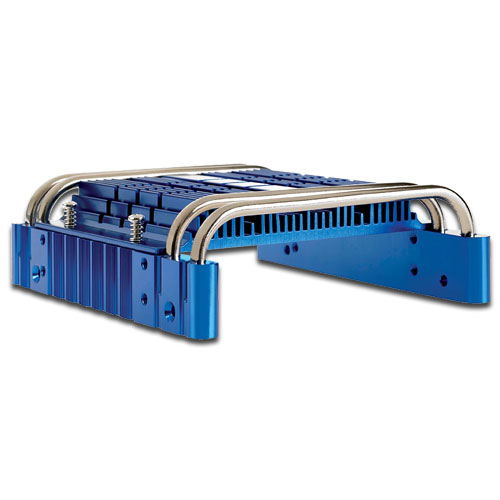
Installation of the ULT40010 is simple, aided by an eight-step illustration supplied in the packaging. The hard drive mounts underneath the cooler, with the top of the drive flush against the cooler's heat transfer plate. Screws pass through the cooler and into the standard mounting holes on the sides of the hard drive. The four rubber dampers screw into the cooler's side, in either an upper or a lower position, to accommodate the style of case that will house the cooler. There are four spring-loaded screws on the top of the ULT40010 that ensure that the cooler's heat transfer plate is firmly pushed up against the top of the hard drive casing; this will ensure maximum surface area contact and thus heat dissipation. The cooler does not use thermal paste, so this is an important consideration.
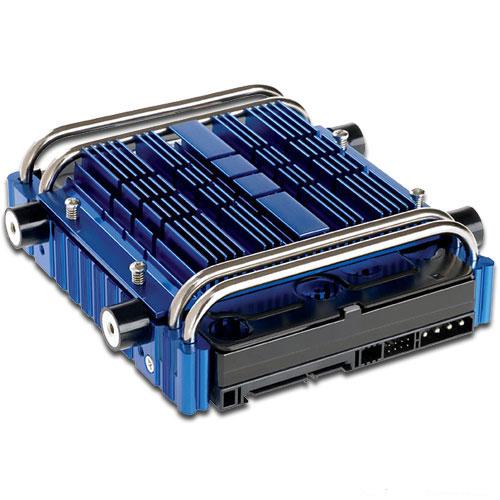
The Ultra cooler installs into a free 5.25" bay in a standard PC case. While removing the front panel isn't necessary, we found it substantially easier to install the assembled cooler from the front of the case, rather than trying to insert it from inside the case cavity. Once the cooler is in place, screws go through the PC case's mounting holes and into a screw hole in the center of the rubber dampers. This results in only rubber mounts touching the PC case, and this helps to lessen drive vibration compared to a standard metal-on-metal mount configuration. Attaching the included grounding strap to a drive mount hole on the PC case completes the installation process.
Test Setup
| Standard Test Bed Test Application Results |
|
| Processor | Intel E6600 - 2.4GHz Dual Core |
| Motherboard | Gigabyte GA-P35-DQ6 |
| RAM | 2 x 1GB OCZ Reaper PC2-6400 Settings: DDR800 4-4-3-9 |
| OS Hard Drive | 1 x Western Digital WD1500 Raptor - 150GB |
| System Platform Drivers | Intel 8.3.0.1013 Intel Matrix RAID 7.6.0.1011 |
| Video Card | 1 x MSI 8800GTX |
| Video Drivers | NVIDIA ForceWare 162.18 |
| Optical Drive | Plextor PX-760A, Plextor PX-B900A |
| Cooling | Tuniq 120 |
| Power Supply | OCZ GXS700 |
| Case | Cooler Master CM Stacker 830 |
| Operating System | Windows XP Professional SP2 |
| . | |
Our thermal tests utilize sensor readings via the S.M.A.R.T. (Self-Monitoring, Analysis and Reporting Technology) capability of the drives. We use the Active SMART 2.6 utility for the reported values. We test our drives in an enclosed case environment without the fans operational; this setup approximates the type of environment found in near silent SFF or HTPC case designs. We typically find the reported numbers drop anywhere from 18% to 25% when the case fans are operational. Our base temperature level in the room at the time of testing is 25C.
As the Ultra cooler will have no impact on the performance of the hard drive, the benchmark focus for this article is on heat dissipation. We could find no impact in terms of noise or vibration during our tests - we'll discuss that in more detail in our conclusion.
For this test, we measure the temperature of the hard drive after the system is idle for an hour (ensuring that the drive has ample time to reach its standard idle operating temperature). We then place a heavy load on the drive by running our PCMark05 HDD test. We monitor heat levels during the test to get a graphical representation of what effects, if any, the Ultra cooler produces.
Test Results
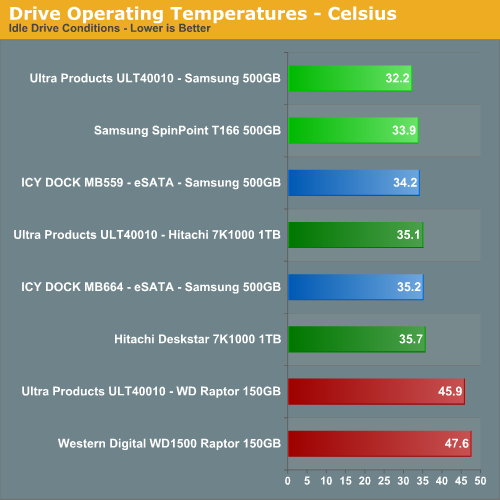
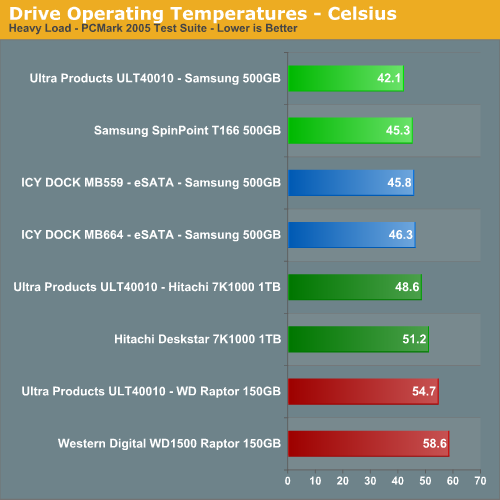
Clearly, the Ultra Products ULT40010 provides superior heat dissipation compared to a bare drive in a standard 3.5" HD case mount. Our Samsung drive, already having earned its reputation as one of the coolest hard drives to grace our test labs, not only runs almost two degrees cooler when mounted using the ULT40010, but it also takes longer to reach this peak temperature. Out of curiosity, we worked the hard drive out in a long (30GB) archive process to see if we could make the heat climb any further, and were only successful in reaching a maximum threshold of one degree higher (43C). The additional surface area of the Ultra cooler (with its cooling fins and heat pipes) allows sufficient thermal transfer to make a noticeable difference, even in our relatively cool-running Samsung drive.
The results were even better with our Hitachi 7K1000 and Western Digital Raptor drives. Idle temperatures on the Hitachi drive only dropped about 1%, but load temperatures dropped over 5% in our test system. The 150GB Raptor has the highest idle and operating temperatures of any hard drive in our labs. As such, this is the drive that would tell us just how well the ULT40010 is designed as a passive cooling unit. We were not disappointed as idle temps dropped 3% and load temperatures decreased over 7%. Once again we ran our 30GB archive test and temperatures did not vary more than 1% over the course of several archive sessions.
Conclusion
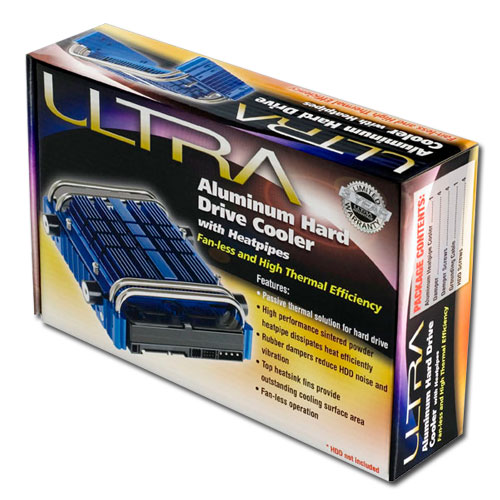
Ultra also advertises that the cooler will reduce noise compared to a standard test setup, but we were unable to discern any difference in our test bed. Presumably, Ultra's claim refers to the rubber mount contacts that reduce case vibration compared to cheaper PC cases that use steel-only hard drive housings. While this claim is certainly true, there has been a trend in the midrange to high-end PC cases to have some type of rubber or foam in place wherever storage devices will contact the case chassis. Given the MSRP of $43 for the ULT40010, it stands to reason that anyone looking at this cooler as an option already has a good quality case with vibration dampening hardware inside. While this does potentially remove one of the items in Ultra's favor, it doesn't take away from the fact that the ULT40010 performs well as a passive hard drive cooler, which is its primary selling point.
The Ultra cooler does what it says, but it doesn't perform miracles. Good active cooling solutions tend to perform better than good passive cooling solutions. While this cooler is indeed an example of a very good passive cooling solution, it does mean that it has somewhat less impact than it likely could if it had (for example) a fan mounted on the top. The trade-off, however, is well worth it to users looking for a case that runs as close to silently as possible. For that reason, Ultra Product's ULT40010 hard drive cooler is an excellent choice for HTPC users, and anyone seeking to help mitigate a hard drive heat problem without adding additional noise to their PC configuration.







